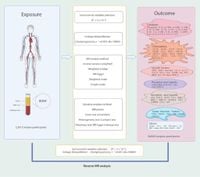In a groundbreaking study, researchers employed Mendelian randomization to explore the complex relationship between brain-derived neurotrophic factor (BDNF) and inflammatory proteins, elucidating how variations in plasma BDNF levels may influence inflammatory responses and contribute to neurodegenerative diseases.
Conducted with data drawn from two comprehensive genome-wide association studies, the investigation analyzed the genetic underpinnings of BDNF correlations with 91 inflammatory proteins across 17,125 participants of European descent. The findings reveal that higher levels of plasma BDNF might be causally linked to lower concentrations of several inflammation-associated proteins.
Brain-derived neurotrophic factor plays a vital role in neural health, critical for processes such as neurogenesis and neuronal survival. However, its relationship with inflammation has remained murky, as prior studies have yielded conflicting results. This latest research provides clarity by utilizing Mendelian randomization, which minimizes confounding factors common in observational studies.
The analysis indicated that elevated plasma BDNF levels are associated with diminished concentrations of inflammatory proteins such as interleukins and neurotrophic factors known to influence neurodegenerative diseases. Specifically, the study identified decreased levels of 13 inflammatory proteins, including IL-33 and CASP-8, when BDNF levels were elevated.
The study’s implications are significant: understanding the causal direction between BDNF and inflammation could inform therapeutic strategies aimed at mitigating inflammation-related neurological disorders. Researchers found that certain inflammatory proteins exhibited either protective effects on BDNF or were negatively associated with it.
The research team's innovative approach is underpinned by robust statistical methods, including the inverse variance weighted analysis, MR-Egger regression, and various sensitivity tests to ensure result reliability. These techniques cater to the complex interactions between genetics and environmental factors.
Through reverse Mendelian randomization, the team also explored how inflammatory proteins might affect BDNF levels. Given that certain inflammatory proteins like CCL23 were found to enhance BDNF levels, this highlights an intricate feedback network where inflammatory processes both influence and are influenced by BDNF.
Future avenues of research may focus on dissecting these relationships further, particularly within the context of specific neurodegenerative diseases like Alzheimer's disease and Parkinson's disease, where inflammation plays a central role in disease pathology. The findings raise important questions regarding the bidirectional relationship between BDNF and inflammation and their collective impact on neurological health.
This study not only advances our understanding of neurobiology but also paves the way for new research targeting the modulation of BDNF and inflammatory processes therapeutically.
As we continue to elucidate the role of neurotrophic factors in inflammation and neuroprotection, it is feasible that therapeutic interventions may emerge that can harness this relationship to ameliorate the burden of neuroinflammatory diseases.




